Main Page
From Sleeping Dragons (Board Game)
Sleeping Dragons (Board Game)
Current Version: Alpha 4.1
(Engine in development, Magic does not work yet, pieces do not have spells. You can currently (Alpha 4.1) play a colorless version of the game only. This is recommended for beginners to the game anyway! =])
Play now! http://www.sleepingdragons.online/game/
How to Play
Sleeping Dragons is a board game played on a 10x10 grid by two players. Each player has their own personalized "Army" of pieces which are placed on squares of their own choice before the game begins. The board is actually made up of two separate 5x10 boards, each half is taken by one player to set up their Army's piece positions, after both players are ready the boards are brought together, and a coin flip determines who takes the first turn.
Sleeping Dragons is a Chess-like game with influences from Magic: The Gathering, but unlike Chess there is no Checkmate. The game is not lost when a Sleeping Dragon dies, but its owner will no longer have it as a Mana source, and could easily be overwhelmed by magic. However if you manage to get a Pawn or Tokin to the opponent's back row you may reanimate your Dragon (see below in "Back Rank Reanimation").
The object of the game is to destroy your opponent's forces. The game is won when all of your opponent's pieces have been captured, or when they admit defeat and resign. The game is a Draw if agreed by both players, if 50 moves go by with no pieces dying, or if the same position is repeated on the board 5 times.
Turns and Turn Phases
Each Turn consists of 3 main phases in this order: Magic Phase, Movement Phase, and End Phase.
Magic Phase
At the start of your Magic Phase you will gain 2 Mana if you have a Sleeping Dragon on the board, 3 Mana if you have an Awakened Dragon on the board, and 1 Mana if you have an Effigy on board.
After this if you have enough Mana, you may choose to cast one of your piece's spells. While any type of spell may be cast during your Magic Phase, only Instant type spells may be cast during other phases.
After this your Movement Phase begins.
Movement Phase
During your Movement Phase you must move one of your pieces. If the movement is a piece capture, during your End Phase you will gain 2 Mana (1 for Pawns / Tokins, and 6 for an Awakened Dragon). After movement is complete the turn moves to your End Phase.
End Phase
During your End Phase, the effects of spells may either resolve, or have their duration counted down until it resolves on a later End Phase. If a piece was captured during the turn's Movement Phase you will gain Mana accordingly at this time.
Mana
Mana is used for two things: awakening your Dragon, and casting spells.
It is generated by Sleeping Dragons (2MPT), Awakened Dragons (3MPT), Effigy piece (1MPT).
It is awarded in different amounts by capturing pieces.
Capturing an Awakened Dragon awards you 6 Mana.
Capturing a Sleeping Dragon or Piece awards you 2 Mana.
Capturing a Pawn or Tokin awards you 1 Mana.
Killing any piece with a spell or spell's effect does not award you any Mana.
Casting Spells
Instant type spells may be cast anytime you have the Mana, either in response to an action made by you or your opponent, or at the end of any turn phase.
Any other type of spell is "sorcery speed" and may only be cast during your own Magic Phase.
Targeting
Magic Targeting works in one of two ways.
For the base cost of the spell, I.E. 3 Mana, the piece casting the spell may target any square it could already move to in a straight line (no jumping or alternating motion targeting). However many spells have costs like this: 3 (+1) - this means for 3 it can target any square it could already move to, and for each +1 additional Mana you pay it may target +1 square farther in the same direction of its movement. If it were 3 (+2) it would be +2 additional Mana for every 1 square farther you want to target. This does not allow the spell to target more than one square, it only extends the range at which it can target. There is no limit on how many times you can pay to extend the range when casting as long as you have the Mana to do it.
A few spells have unique targeting specified in their own rules. Some cast from the square the casting piece currently occupies.
Mana Strategy
There are 4 main strategies you can choose to employ:
1: Conservative, strictly saving Mana until you can awaken your Dragon. This means casting no spells, or only what is necessary, until after your Dragon is awakened. Afterwards your MPT (Mana Per Turn) increases from 2 to 3, allowing you to cast spells more often.
2: Hybrid, keep a priority of saving Mana, but also look for spell / movement combos. Use spells in moderation and try to build up Mana to awaken your Dragon.
3: Spellcaster, disregard the idea of ever awakening your Dragon at all, and use Mana to cast spells every turn or every other turn instead. Always look for spell / movement combination attacks.
4: Trickster, strictly saving your Mana so it seems your goal is to awaken your Dragon, but secretly looking for double spell / movement combinations to surprise attack in a devastating way. Or if no combinations come up, just awaken your Dragon and let it do its thing.
A Sleeping Dragon
What is a Sleeping Dragon anyway?
When you select the pieces in your Army you will have many Dragon options to choose from! Each of them have overpowered movesets and powerful magic, many of them have unique spells too powerful for other pieces to have. They begin the game asleep, which means they cannot move, and only generate 2 Mana Per Turn (MPT). Each Dragon has a unique Awakening Cost, which is the amount of Mana required to awaken it. This allows it to move and cast spells like any other piece, and it will now generate you 3 MPT. However if your Dragon dies it will not be there to continue generating Mana for you.
Dragons are the Queens of this game, but in their power they hold value you must still protect.
Pawns and Tokins
When you select the pieces in your Army you will also get to choose either Pawns or Tokins to lead your charge, to create your structure, to attack and defend with.
Pawns move diagonally-forward 1 square only (depicted below in movesets), and cannot move back. Their ability to move two different forward directions is strong for attacking, and difficult to stop when they get past enemy lines.
Tokins move forward or backward 1 square only (depicted below). Their backward moving ability is powerful and good for defending.
Back Rank Reanimation
When a Pawn or Tokin reaches the opponent's back rank it will die on its controller's end phase, at that time that player may choose any dead piece they originally controlled, and reanimate it anywhere on their back three rows which is not currently an occupied space.
Official Game Formats:
Colorless Duel
-No more than 2 copies of the same Piece type allowed per army
-4 Colorless Pieces, and 5 Pawns or Tokins
Standard Duel
-No more than 2 copies of the same Piece type allowed per army
-2 different Color variants allowed per army
-2 Colored Pieces, and 2 Colorless Pieces, and 5 Pawns or Tokins
-up to 1 Specialty Type Pieces allowed per army
-1 Effigy
Royal Duel
-No more than 2 copies of the same Piece type allowed per army
-Each player begins the game with 16 Mana
-3 different Color Variants allowed per army
-Up to 2 Specialty Type Pieces allowed per army
-4 Colored Pieces, and 5 Pawns or Tokins
-No Dragons or Effigies allowed
Colorless Standard
-No more than 2 copies of the same Piece type allowed per army
-7 Colorless Pieces, and 10 Pawns or Tokins
-Up to 3 Specialty Type Pieces allowed per army
-1 Colorless Dragon
Standard
-No more than 2 copies of the same Piece type allowed per army
-2 different Color Variants allowed per army
-Up to 3 Specialty Type Pieces allowed per army
-7 Pieces, and 10 Pawns or Tokins
-1 Dragon (must match color identity with one of your pieces, or be colorless)
Royal Standard
-No more than 2 copies of the same Piece type allowed per army
-Up to 3 different Color Variants allowed per army
-Up to 4 Specialty Type Pieces allowed per army
-8 Pieces, and 10 Pawns or Tokins
-1 Dragon (must match color identity with one of your pieces, or be colorless)
Double Dragons Standard
-No more than 2 copies of the same Piece type allowed per army
-Up to 2 different Color variants allowed per army
-Up to 3 Specialty Type Pieces allowed per army
-7 Pieces, and 10 Pawns or Tokin
-2 Dragons (Each must match color identity with one of your pieces, or be colorless)
Double Effigy Standard
-No more than 2 copies of the same Piece type allowed per army
-Up to 2 different Color Variants allowed per army
-Up to 2 Specialty Type Pieces allowed per army
-7 Pieces, and 10 Pawns or Tokins
-2 Effigies
Pieces, and how they move:
Pawns and Tokins
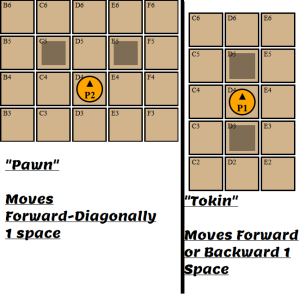
Normal Pieces
(Release Version a4.1)
General
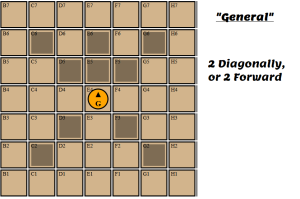
Rabbit
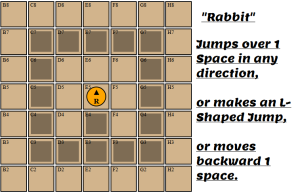
Horse
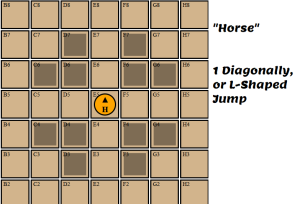
Bullfrog
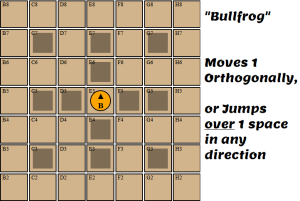
Bear
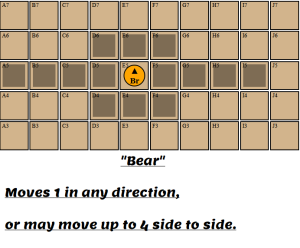
Chariot
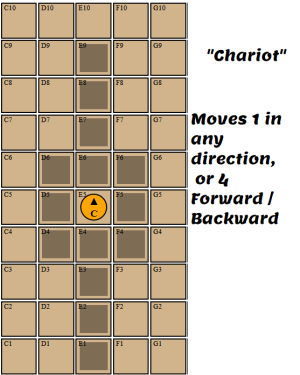
Specialty Pieces
(Release Version a4.1)
Mage
Battlemage
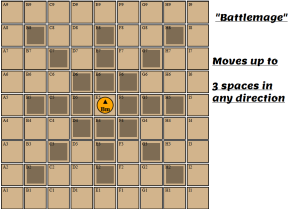
Crane
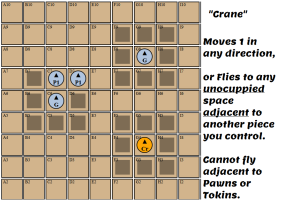
Snake
Leopard
Wolf
Effigy
Dragons
(Release Version a4.1)
Colorless Dragon
Ice Dragon
Fire Dragon
Hydra Dragon
Effigy of a Dragon
Color Variants
(Release Version a4.1)
Blue Variants
Red Variants
Yellow Variants
Colorless Variants
All Spells
(Release Version A4.1)